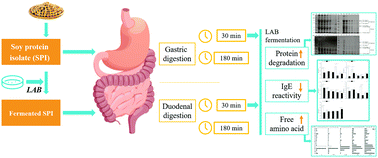Assessment of the effect of lactic acid fermentation on the gastroduodenal digestibility and immunoglobulin E binding capacity of soy proteins via an in vitro dynamic gastrointestinal digestion model
Abstract
Fermentation by lactic acid bacteria is helpful in reducing soy protein immunoreactivity. However, how lactic acid fermentation influences the gastroduodenal digestibility and immunoglobulin E (IgE) binding capacity of soy proteins remains unclear. In this study, the protein digestion of a fermented soybean protein isolate (FSPI) was investigated and compared with that of a soybean protein isolate (SPI). The effect on their respective IgE binding capacities at the gastric and duodenal phases was also explored by using a novel in vitro dynamic gastrointestinal digestion model (Bionic Rat Model II+). Medium pH was measured, microstructural analysis was performed, peptide distribution and free amino acid content were determined, and SDS-PAGE analysis was performed to assess the differences between SPI and FSPI. The results showed that FSPI had lower pH (3.76), larger protein aggregates (>60 μm), and higher low-molecular-weight peptides than SPI. During the first 30 min of gastric and duodenal digestion, the extent of hydrolysis of FSPI was higher than that of SPI, and the gastric transition time of the former was longer than that of the latter. Conversely, differences tended to be narrower in the next 30–180 min of gastric and duodenal digestion. As a result, the IgE binding capacity of FSPI was significantly lower than that of SPI at 30 min of gastric and duodenal digestion. Therefore, fermentation by lactic acid bacteria affected the digestibility rate of soy proteins, especially at the initial phases of gastric and duodenal digestion, thereby reducing the exposure of intact epitopes in the duodenum. This study helped to elucidate how lactic acid fermentation affected the digestive behavior of soy proteins and its implication in IgE immunoreactivity reduction.

- This article is part of the themed collection: Food & Function Recent HOT articles


 Please wait while we load your content...
Please wait while we load your content...